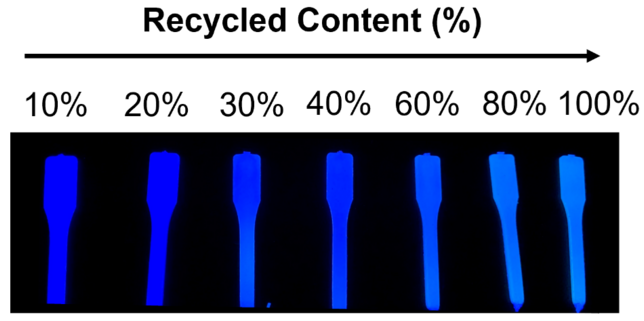Reviewed by Mila PereraSep 22 2022
Single-use plastic items that are made up of below 30% recycled material are taxed in the United Kingdom to motivate recycling. Other than the manufacturer’s word, however, there is no other method to confirm this composition.

Adding a fluorescent tag to recycled plastics could help track their amount in new single-use products. Image Credit: ACS Sustainable Chemistry & Engineering, 2022
Scientists have created a basic, fraud-resistant method to assess the recycled content of new plastic items. They incorporated a fluorescent tag into plastic resins to track their quantity in new single use plastics. Details of their new method can be found in ACS Sustainable Chemistry & Engineering.
After reducing and reusing, recycling is the last line of defense to keep plastics out of the landfill. Recently, certain countries have been levying financial pressure on manufacturers to force them to adapt the program.
While the United Kingdom is imposing taxes on plastic items with insignificant recycled content, nations like Spain and Italy will soon levy taxes on items that comprise no recycled material.
Methods to validate these amounts are not always accurate, leading to deception and public distrust. One solution is to tag recycled polymers with the fluorescent molecule 4,4,-bis(2-benzoxazolyl) stilbene (BBS), then monitor the tagged plastic items in the resulting products.
BBS’s fluorescence color and intensity differ when various levels exist. It is also low-cost and permitted for food contact applications. Michael Shaver and co-workers were, therefore, keen to see how BBS could be employed to quantify the recycled content of single-use items.
The scientists blended small quantities of BBS into liquefied high-density polyethylene (HDPE), then blended that with virgin HDPE resin, mimicking 0 to 100% recycled-content materials.
When the quantity of BBS-tagged HDPE increased in the samples, the fluorescence intensity moved toward a greener kind of blue under a fluorescent light.
The marked polymer had distinctive fluorescence features, which the scientists say would be challenging for anyone with fraudulent intentions to replicate.
The researchers subsequently formulated a basic digital image analysis method that turned the material’s fluorescence into the percentage of recycled material.
In trials, the technique could detect the recycled content in other everyday polymers, such as colored HDPE, polypropylene, recycled milk bottles with additives, and poly(ethylene terephthalate).
The team believes that they could use the BBS method on a range of single-use plastic items without affecting their quality or appearance.
The authors received funding from the Sustainable Materials Innovation Hub, the Henry Royce Institute for Advanced Materials, and the Manchester Institute of Biotechnology.
The team has filed a patent on this technology in the United Kingdom.
Journal Reference
Schyns, Z. O. G., et al. (2022) Recycled Plastic Content Quantified through Aggregation-Induced Emission. ACS Sustainable Chemistry & Engineering. doi.org/10.1021/acssuschemeng.2c03389.